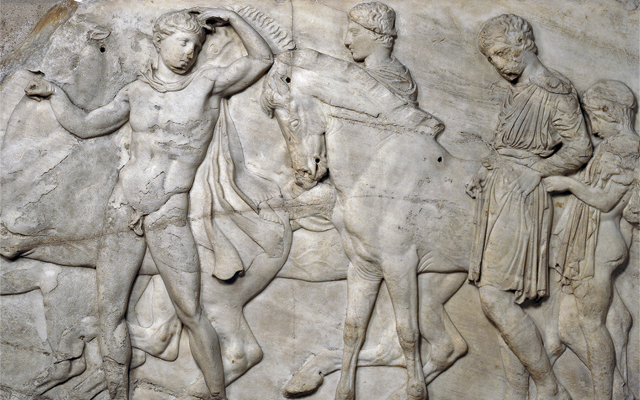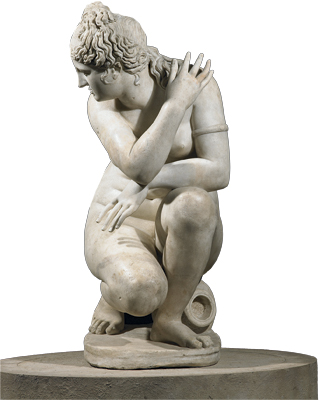Exhibition review: Defining Beauty at the British Museum
Ruth Guilding is seduced by a show dedicated to the human form.


If you go down to the British Museum today, you will encounter some of the most important and fabulous loans ever to go on show there. ‘Defining Beauty’ offers the visitor dozens of bronze and marble ‘bodies’ chosen not only for their corporeal beauty, but also for their power to elucidate the narratives of Greek sculpture.
The male elite of ancient Athens — its philosophers, citizens, soldiers and athletes — equated inner moral beauty with the physically perfect bodies of the gods and god-like men exhibited here. In these male bodies, sensory delight, citizenship and intelligent mind were conjoined, a legacy that has passed down through the Italian Renaissance to our modern times.
Now, as then, victorious athletes have heroic status; our national icon David Beckham stands ambassador for Britain’s Olympic bid and models designer boxer shorts, his bulging pectorals lightly brushed with oil.
Those of us lucky enough to attend the museum’s press view heard exhibition curator Ian Jenkins explaining the philosophical associations of the ideal body in Classical times. Under the influence of his eloquent words, chilly stone and marble forms came to life as the bearers of ancient meaning.

Standing by the 2nd-century Roman sculpture of a crouching Venus or Aphrodite, a version of a lost Greek original that has belonged successively to Court painter Sir Peter Lely, Charles I and the Royal Collection, Dr Jenkins urged us to walk around her and observe how her inwardly turned body, protectively crossed arms and backward glance contrived to deflect our intrusive human gaze.
Aphrodite, the goddess of love, is alone among the female Olympian gods in being represented naked. Here, her maker had given us the goddess — one of the family of gods living upon Mount Olympus whose vices and foibles are vividly described in Homer’s epic poetry of the 8th century bc — in human form, as if caught emerging from her bath. She was, Dr Jenkins explained, both divine body and embodiment of the deity, vain and fickle, but witha ‘divine and dangerous stare’.
Throughout the galleries that follow, Dr Jenkins has staged ‘encounters’ between the sculptures in this exhibition and their 21st-century audience. To this end, he has brought the gods and goddesses down from their high plinths and pedestals; even the great River God of the Parthenon has descended to Earth. We walked among them, observing the exquisite contour of a breast, the lunge of a muscle-bound forearm, and were moved, instructed, alarmed and overwhelmed.
Sign up for the Country Life Newsletter
Exquisite houses, the beauty of Nature, and how to get the most from your life, straight to your inbox.
A Roman marble statue of a wounded Amazon, modelled on a 5th-century-BC original by Polykleitos, is a creature of pathos, a predatory killer, tamed and vulnerable, shown subject to the uncertainty of fate and human fortune. The marble statue of a standing Aphrodite of the Capitoline Venus type from the museum’s core collection personifies erotic desire, spiced with a hint of divine threat. For context, the story of the legendary lost statue of Aphrodite made by Praxiteles and venerated in her shrine at Knidos is recounted, telling how Aphrodite came through the waves to Knidos wishing to see her own image and, having viewed it from all sides, cried angrily: ‘Where did Praxiteles see me naked?’
Socrates (whose tubby little body was famously at odds with the beauty of his mind), explained how painters and sculptors might achieve the ideal: ‘You bring together from many models the most beautiful features of each.’ The prize for the most physically perfect male body in this exhibition must surely go to the over-lifesize bronze of a Greek athlete dating from 300BC — a rare survivor, exhumed from its weedy ocean bed at the bottom of the Adriatic off the coast of Croatia a few years ago.
This absurdly be

autiful creature (left), whose lips and nipples are inlaid with coral coloured copper, personifies the apogee of Greek humanism in which ‘Man is the measure of all things’. Scraping his supple thigh with a strigil, he transports us to the wrestling school in which Grecian youths competed, honing their fitness for moral and military combat. An expressive bronze baby from the 1st century ad, loaned from the Daniel Katz Gallery, pouts and reaches out his podgy arms to be picked up with an urgent appeal, conjuring another kind of human desire.
The quest for the ideal body was brought home to the British Museum when Lord Elgin’s marbles arrived in London at the beginning of the 19th century. The monumental bookends to this show are two authentic Greek bodies from Elgin’s endowment. In the first gallery, the Ilissos river god from the west pediment of the Parthenon is on magnificent display, having just returned from its recent loan to the Hermitage in St Petersburg, a source of contention for Greece.
In the last gallery, the 1st-century-AD Belvedere torso from the Vatican Museum in Rome, highly revered from Renaissance times, pays homage to the reclining Dionysos from the Parthenon’s east pediment. In setting up these mighty forms as the fons et origo of this exhibition’s narrative, the British Museum makes a cogent political point in support of its stewardship of the marbles.
These transformative and inspirational stone sculptures, with their indefinable beauty that inspired the poet John Keats, contribute to our modern European idea of what it means to be human. They represent all mankind.
Ruth Guilding is the author of ‘Owning the Past; Why the English Collected Antique Sculpture, 1640–1840’ (2014) ‘Defining beauty: the body in ancient Greek art’ is at the British Museum, Great Russell Street, London WC1, until July 5 (020–7323 8181; www.britishmuseum.org)
Country Life is unlike any other magazine: the only glossy weekly on the newsstand and the only magazine that has been guest-edited by HRH The King not once, but twice. It is a celebration of modern rural life and all its diverse joys and pleasures — that was first published in Queen Victoria's Diamond Jubilee year. Our eclectic mixture of witty and informative content — from the most up-to-date property news and commentary and a coveted glimpse inside some of the UK's best houses and gardens, to gardening, the arts and interior design, written by experts in their field — still cannot be found in print or online, anywhere else.
-
 Vertigo at Victoria Falls, a sunset surrounded by lions and swimming in the Nile: A journey from Cape Town to Cairo
Vertigo at Victoria Falls, a sunset surrounded by lions and swimming in the Nile: A journey from Cape Town to CairoWhy do we travel and who inspires us to do so? Chris Wallace went in search of answers on his own epic journey the length of Africa.
By Christopher Wallace
-
 A gorgeous Scottish cottage with contemporary interiors on the bonny banks of the River Tay
A gorgeous Scottish cottage with contemporary interiors on the bonny banks of the River TayCarnliath on the edge of Strathtay is a delightful family home set in sensational scenery.
By James Fisher